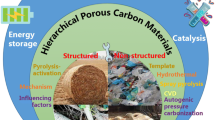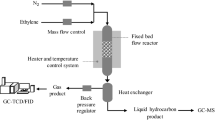Abstract
Ammonium perchlorate (AP) includes oxidizing and reducing elements on the same molecule. AP can act as an efficient oxidizer and mono-propellant as well. In this study, AP experienced crystallographic phase change from orthorhombic centrosymmetric to non-centrosymmetric under controlled isothermal heat treatment. XRD diffractograms confirmed this crystallographic phase change. The thermal behaviour of activated AP had been investigated using DSC. Activated AP demonstrated high chemical stability with an increase in endothermic phase transition enthalpy by 170%. The enthalpy of the subsequent two main exothermic decomposition reactions was increased by 250%. Whereas AP demonstrated total decomposition enthalpy of 733 J/g, activated AP showed 2614 J/g. Activated AP can secure self-sustained response at a high rate. Propagation index (combustion enthalpy/ignition temperature) was employed to assess self-sustained reaction propagation. Activated AP demonstrated high propagation index of 8.7 compared with 2.5 for un-activated AP. Primary decomposition kinetic parameters had investigated using Kissinger and KAS methods. Activated AP showed an increase in activation energy by 89% using the Kissinger method; kinetic parameters using the KAS method were in good agreement with the Kissinger method. It can have concluded that AP with novel kinetic decomposition parameters for enhanced safety storage and high combustion characteristics has evolved.
Similar content being viewed by others

References
Conkling J., Mocella C., Chemistry of pyrotechnics basic principles and theory. Second ed., CRC: London, 2012.
Elbasuney S., Gobara M., Yehia M., Ferrite nanoparticles: synthesis, characterization, and catalytic activity evaluation for solid rocket propulsion systems. Journal of Inorganic and Organometallic Polymers and Materials, 2019, 29: 721–729.
Elbasuney S., Gobara M., Zaky M.G., Radwan M., Maraden A., Ismael S., Elsaka E., Abd Elkodous M., El-Sayyad G.S., Synthesis of CuO-distributed carbon nanofiber: Alternative hybrid for solid propellants. Journal of Materials Science: Materials in Electronics, 2020, 31(11): 8212–8219.
Elbasuney S., Yehia M., Ammonium perchlorate encapsulated with TiO2 nanocomposite for catalyzed combustion reactions. Journal of Inorganic and Organometallic Polymers and Materials, 2019, 29: 1349–1357.
Elbasuney S., Yehia M., Thermal decomposition of ammonium perchlorate catalyzed with CuO nanoparticles. Defence Technology, 2019, 15(6): 868–874.
Elbasuney S., Yehia M., Ferric oxide colloid: a novel nano-catalyst for solid propellants. Journal of Inorganic and Organometallic Polymers and Materials, 2020, 30(3): 706–713.
Kubota N., Propellants and explosives: thermochemical aspects of combustion. WILEY-VCH: Weinhei, 2002.
Cai W., Thakre P., Yang V., A model of AP/HTPB composite propellant combustion in rocket-motor environments. Combustion Science and Technology, 2008. 180(12): 2143–2169.
Yadav N., Srivastava P.K., Varma M., Recent advances in catalytic combustion of AP-based composite solid propellants. Defence Technology, 2021, 17(3): 1013–1031.
Kuo K.K., Summerfield M., Fundamentals of solid-propellant combustion. American Institute of Aeronautics and Astronautics, Inc.: New York, 1984.
Sharma J.K., Srivastava P., Singh G., Akhtar S.M., Ameen S., Biosynthesized NiO nanoparticles: potential catalyst for ammonium perchlorate and composite solid propellants. Ceramics International, 2015, 41(1, Part B): 1573–1578.
Ishitha K. Ramakrishna P.A., Studies on the role of iron oxide and copper chromite in solid propellant combustion. Combustion and Flame, 2014, 161(10): 2717–2728.
Arroyo J.L., Povea P., Faúndez R., Camarada M.B., Cerda-Cavieres C., Abarca G., Manriquez J.M., Morales-Verdejo C., Influence iron-iron distance on the thermal decomposition of ammonium perchlorate. New catalysts for the highly efficient combustion of solid rocket propellant. Journal of Organometallic Chemistry, 2020, 905: 121020.
Dubey R., Chawla M., Siril P.F., Singh G., Bi-metallic nanocomposites of Mn with very high catalytic activity for burning rate enhancement of composite solid propellants. Thermochimica Acta, 2013, 572: 30–38.
Davenas A., Solid rocket propulsion technology. PERGAMON PRESS: Oxford, 2012.
Yang V., Brill T., Ren E.Z., Solid propellant chemistry, combustion, and motor interior ballistics. American Institute of Aeronautics and Astronautics, Inc., USA: Reston, Virginia. 2000.
Budhwar A.S., et al., Modified iron oxide nanoparticles as burn rate enhancer in composite solid propellants. Vacuum, 2018. 156: 483–491.
Vara J.A., Dave P.N., Ram V.R., Nanomaterials as modifier for composite solid propellants. Nano-Structures & Nano-Objects, 2019. 20: 100372.
Vijay C., Ramakrishna P.A., Estimation of burning characteristics of AP/HTPB composite solid propellant using a sandwich model. Combustion and Flame, 2020. 217: 321–330.
Jain S., Qiao L., MnO2-coated graphene foam micro-structures for the flame speed enhancement of a solid-propellant. Proceedings of the Combustion Institute, 2019, 37(4): 5679–5686.
Maggi, F., Dossi S., Paravan C., Galfetti L., Rota R., Cianfanelli S., Marra G., Iron oxide as solid propellant catalyst: A detailed characterization. Acta Astronautica, 2019, 158: 416–424.
Kuo K.K., Summerfield M., eds. Fundamentals of solid-propellant combustion. third ed., American Institute of Aeronautics and Astronautics, New York, 1984.
Vyazovkin S., Burnham A.K., Criado J.M., Pérez-Maqueda L.A., Popescu C., Sbirrazzuoli N., ICTAC Kinetics Committee recommendations for performing kinetic computations on thermal analysis data. Thermochimica acta, 2011, 520(1–2): 1–19.
Trache D., Khimeche K., Mezroua A., Benziane M., Physicochemical properties of microcrystalline nitrocellulose from Alfa grass fibres and its thermal stability. Journal of Thermal Analysis and Calorimetry, 2016, 124(3): 1485–1496.
Akahira T., Sunuse T.T., Joint convention of four electrical institutes. Research Report, Chiba Institute of Technology, 1971, 16: 22–31.
Liu W., Xie Y., Xie Q., Fang K., Zhang X., Chen H., Dropwise cooling crystallization of ammonium perchlorate in gas-liquid two-phase suspension systems. CrystEngComm, 2018, 20(43): 6932–6939.
Abd Elkodous M., et al., Nanocomposite matrix conjugated with carbon nanomaterials for photocatalytic wastewater treatment. Journal of Hazardous Materials, 2020, 410: 124657.
Boldyrev V., Thermal decomposition of ammonium perchlorate. Thermochimica acta, 2006, 443(1): 1–36.
Elbasuney S., Fahd A., Mostafa H.E., Mostafa S.F., Sadek R., Chemical stability, thermal behavior, and shelf life assessment of extruded modified double-base propellants. Defence Technology, 2018, 14(1): 70–76.
Elbasuney S., Zaky M.G., Radwan M., Mostafa S.F., Stabilized super-thermite colloids: a new generation of advanced highly energetic materials. Applied Surface Science, 2017, 419: 328–336.
Acknowledgments
The authors would like to thank Chemical Engineering Department, Military Technical College (MTC), Egyptian Armed Forces, Cairo, Egypt for their invaluable support of this study.
Author information
Authors and Affiliations
Corresponding authors
Rights and permissions
About this article
Cite this article
Sherif, E., Yehia, M., Shukri, I. et al. Thermochemical Aspects of Activated Ammonium Perchlorates with Superior Thermal Stability, Decomposition Enthalpy, Propagation Index, and Decomposition Kinetic Parameters. J. Therm. Sci. 30, 2196–2201 (2021). https://doi.org/10.1007/s11630-021-1498-0
Received:
Published:
Issue Date:
DOI: https://doi.org/10.1007/s11630-021-1498-0



